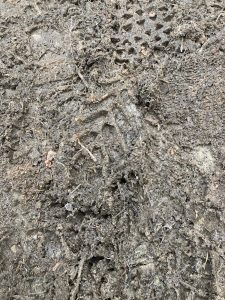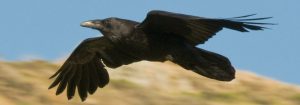worm grunting
May Hill hovering on the horizon
The fitter your legs, the fitter your mind. This is what I told myself as I slogged up Bradlow Hill to my favourite viewing spot one harsh cold morning last week. It’s good for you, colder temperatures help people think clearly, people perform tasks better. What’s more, people are less inclined to tackle cognitive problems in the summer, as opposed to winter, because the warm weather uses more glucose that’s needed for mental processes.
Yes, a long, brisk walk is as good as a run when it comes to lowering risk of high blood pressure and high cholesterol because it’s the total energy used, you see, rather than the intensity of the workout, that counts.
Encouraged, I tried tackling a cognitive problem. When did time begin? Where does a thought go when it’s forgotten? Where do lost socks go when they are missing? No answer presented itself.
But it was cold. Very cold. Everything was covered in wispy white and the mud, usually so slippery and just waiting to play with you, was ice solid and didn’t try any of its old tricks. I decided it was a hoar frost. Later, when I got home, I looked up “hoar” – it comes from an Old English adjective that means “showing signs of old age”. In this context, it refers to the frost that makes trees and bushes look like white hair. It is formed by direct condensation of water vapour to ice at temperatures below freezing.
More cognitive problems: which came first – the chicken or the egg? Why do men have nipples? What would happen if somebody hired two private detectives to follow each other? At a cinema or theatre, which armrest is yours? What happens to worms when the earth above them has frozen? Just think how nice it would be to sleep curled up in a warm place, like a worm when the temperature goes down and the frost appears. They burrow below the frost line where they nest in chambers at the bottom of tunnels they dig, kept moist by the slimy mucus they produce. All that soil above them keeping them warm, like a blanket – bad news for birds, no matter how early they get up on a cold winter’s day.
Do worms communicate? Do they produce any sound? My research later showed up all sorts of interesting facts, like worm grunting – which is the art of rubbing iron and wood to cause vibrations in the ground that cause worms to wriggle to the surface – but I read that earthworms do not have vocal cords, lungs or larynx to drive air through and generate noise, and why didn’t I enrol in a biology class, it was suggested, and get a life.
Looking around at the whitened landscape another cognitive problem came to me. What makes stoneware and porcelain white? I know this one: kaolin, or rather kaolinite, a mineral. Kaolin is the only type of clay from which a white, translucent, vitreous ceramic can be made. It is a refractory clay, meaning that it can be fired at high temperatures without deforming, and it is white-burning, meaning that it imparts whiteness to the finished ware, be it stoneware or porcelain. Ceramicists like Edmund de Waal usually like their pieces in their pure white state.
Much as I like the white of stoneware and porcelain, because I am a painter, I feel the need to colour the surface with stains and oxides before dipping the piece in a transparent glaze and firing it to 1275℃.
By the way, it turns out that Kaolinite is also used in toothpaste, incandescent lightbulbs, cosmetics, paint, whitewash and paper. Some people even eat it to help digestion or to lower food toxicity, but don’t try it at home.
When I got to the top of the hill, I saw that someone had already beaten me to CJ’s bench and left his or her mark. In full Sherlock cognitive mode, I studied the patch left by the person’s bottom on the frosted wood: hmmm, not a large person, and very confident of the waterproof clothing worn, and given the heat required to melt the ice, I surmised the person had, like me, climbed the hill to the bench to generate such heat. Therefore, the person was ahead of me and in the woods. I decided not to test the theory. If I rushed ahead and approached walkers ahead of me whilst looking for damp patches on their bottoms I would only get into trouble.
Instead, I looked at the low wintry skyline and noticed a thin finger of cloud below the top of May Hill, which made it look as if it were floating just above the horizon.
The rest of the walk through the woods was uneventful with only a few walkers crossing paths, no squirrels, no birdsong, only the neighbourhood raven who always croaks way above the trees. It made me think of Merlina, the Queen raven that recently disappeared from the Tower of London, presumed dead. It was Charles II who officially decree that the birds must be kept at the Tower at all times (otherwise the kingdom would collapse), and when numbers fell to just a single raven guard, Winston Churchill ordered that the flock — known as an “unkindness” — was increased to at least six.
Seeing the landscape beyond through the vertical grid of the trees, I was reminded of a vase I made some time ago, thus the next two pictures:
You may have noticed that I have taken the advice of my marketing manager, St Spyridon (see previous blog), and have scattered images of recently made vases throughout this blog in a haphazard manner unrelated to the text. He assures me it is called scattergun influencer marketing and all the kids are doing it, and why am I calling this blog worm grunting? It’s got nothing to do with ceramics.
Nor has this: some of you who read my verbiage, my waffle, my flannel, might be interested in listening to me read a section from a short story called sibling published in Brittle Star. Please join us for the magazine’s first ever virtual launch, hosted by the Barbican Library through Zoom. Free to attend, just click here to register. It is the publication’s twentieth birthday, with readings by contributors strictly limited to five minutes each. There will be no ceramics on view, no matter what Spiro says about it being a great marketing opportunity. It will be on 26th January at 6pm until 7pm (UK time).
Keep well.


























